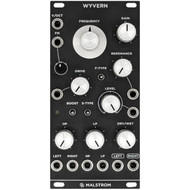Wyvern - Malstrom
by Ian Rapp
Malstrom's modules have direction; they take signals along of path both in terms of flow and layout, and it makes them intuitive to use. Wyvern, their multi-function tone shaping module, follows suit and can be broken down into three stages; Filter EQ, Saturation, and Post-Saturation (wouldn't anything that comes after the Saturation stage be post? Ah well…semantics!). Starting at the top left with the Filter EQ stage, you've got some very interesting and unexpected twists here that really maximize how much you can squeeze out of just a little. The Frequency control lets you fine tune the frequency you want to home in on, while the bi-polar Gain control lets you adjust how much of that frequency is amplified. With a three-button selector toggle for choosing filter type, you can tweak the Gain and change the filter types; with the Gain fully CW you have low shelf, bell, and high shelf and if the Gain is fully CCW, that offers up filter types of low pass, notch, and high pass. Pretty cool. With the help of the Resonance—which has a CV input to modulate it—the filter can go into self-oscillation and be tracked through its 1V/Oct input. There's also an FM input for the filter, with an amount control, to get more complex sounds. With most filters you get to reduce frequencies (and boost the peak if there's a resonance control), but with Wyvern, it's so flexible, you have the ability to increase or decrease a frequency and adjust how much. With the Gain control being positive or negative, it really takes the filter/eq concept and opens it up, offering a lot of possibilities and flexibility in a pretty small footprint. As I said, with the way that maelstrom lays out a path for your signal, it gives you a bit of a step-by-step formula for shaping.
The next step is the Saturation stage, so after you dial in the frequencies you want to thicken, you find yourself with a Drive (with a CV in). A Boost switch with three options (x1, x2, x4) gives you the option of how hard you want to hit the Drive on the front end, so that you can get all sorts of different harmonic qualities from your signal. There's also a saturation switch to choose the type you want; All-pass distortion, Hard Clipping, and Soft Clipping. Combined with a Level control (which acts like a VCA when CV is patched in), the saturation portion of Wyvern is, like the Filter EQ section, extremely versatile. The two clipping saturations are pretty similar, but still offer some nice variation between them.
Wyvern's final stage is the Post-Saturation stage, and here you can further dial in the frequency range you want with an HPF and LPF (with CV ins) and a Dry/Wet mix knob. With the CV ins for this you can get experimental, but I mostly used this section to define the boundaries of whatever I had patched into it, so that my signal would sit better in a mix. In this way—taking off the low end or restricting the high—it was invaluable. For melodies and bass lines, it's interesting to see how much better you can mix with something like this in your rig, no more fighting for space in the frequency spectrum. Or at least, less fighting.
Wyvern is quite a surgical little thing, with not just the ability to shape your tone, but to adjust it at various points along the path. Sometimes I found that I would end up at the same sound anyway, but using a different set of parameter adjustments to get there. I love this type of experimenting—it brings about a certain amount of thoughtfulness and challenge that most instruments don't venture into.
Like the other two Malstrom modules (why only two?!!!), Mandrake and Arkan, Wyvern is way more than you'd think. It's a great tone controller/shaper, and excels as an end of chainer, but is almost a necessity for drums, as both a colorer/saturator and to sculpt the tone and boundaries. And for melodies, as a distortion/saturation machine, and a quasi-phaser, Wyvern proved to be so versatile and great sounding that it was a tough choice in a patch to use it on drums, melodies, or everything. I do wish there was labeling for the toggles with respect to the options each offers, and I would love CV control over Frequency Gain as that could be really interesting so you could modulate filter types with the alternating positive/negative voltage of the Gain control, but aside from that short wish list, I highly recommend this if you want to add some juice to your track.
Price: $399


